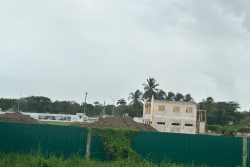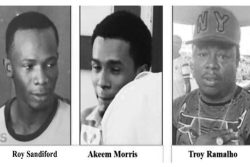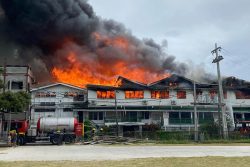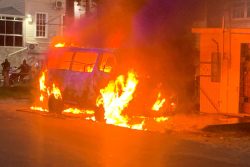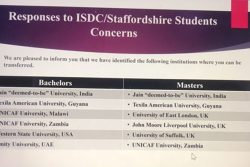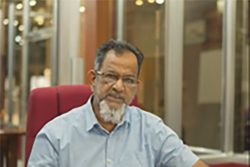BEIRUT, (Reuters) – The voice crackling over the Hezbollah radios was clear and authoritative, and the guerrillas poised to attack the Syrian border town of Qusair recognised it immediately.
“As I promised you victory before, I pledge you victory now,” Hezbollah leader Sayyed Hassan Nasrallah said, launching a battle in which his fighters decisively defeated rebels trying to topple President Bashar al-Assad.
Nasrallah told his troops that God was fighting alongside them, one of the fighters told Reuters. “When we heard his voice, we were ready to fight the whole world,” he said.
It was a trademark coup de theatre from the reclusive Nasrallah, who has bred an aura of mystique around a force which grew from a shadowy Iranian-backed Lebanese militia into an outfit powerful enough to confront regional superpower Israel.
Hezbollah’s victory across the Syrian frontier in Qusair highlighted its pivotal role in Assad’s fightback against rebels and yet, as in most of its military operations, it has given few details of its role – or where its next battle may be.
“Wherever we need to be, we will be…. There is no need to elaborate,” Nasrallah said in a televised speech on Friday, delivered as ever from a secret location because of fears for his security since Hezbollah fought a war with Israel in 2006.
The need for ambiguity is greater than usual, with Shi’ite Hezbollah’s open intervention in a foreign conflict against Sunni Muslim rebels fuelling sectarian tensions and shattering its status across the Arab world as an anti-Israeli champion.
But the movement has always tried to keep its enemies guessing about its strengths.
Estimates of the number of fighters it committed in Qusair vary from the hundreds to several thousand, although most observers put the figure at between 1,500 and 2,500.
Hundreds of other Hezbollah fighters are also deployed in Syria, according to the Syrian Observatory for Human Rights.
They are stationed around the Shi’ite shrine of Sayyida Zeinab near Damascus with dozens more in two Shi’ite towns in the northern province of Aleppo – mainly training and advising – and in the Zahra quarter of the city of Homs, it says.
The British-based anti-Assad monitoring group says 156 Hezbollah fighters have been killed so far in Syria, most of them in the battle for Qusair.
A security source in Israel said he believed Hezbollah had 4,000-5,000 fighters in Syria and had lost between 180 and 200.
STRONGER THAN BEFORE
Hezbollah’s overall strength is also unclear, although analysts and defence experts agree it has grown substantially since it fought the inconclusive 34-day war with Israel seven years ago, firing rockets deep into the Jewish state.
Those kind of cross-border salvoes mean that much of the focus on Hezbollah’s military power in the past has been on its missiles, which Nasrallah said last year could hit targets anywhere in Israel.
Its fighters are as well-armed as some regional armies, using anti-tank missiles, rocket-propelled grenades and mortars. Hezbollah flew a drone over Israel last year and in the 2006 war was able to hit an Israeli warship off the Mediterranean coast.
But with no shortage of weapons in Syria, Hezbollah’s main contribution to Assad’s war effort is military expertise.
The movement’s military structure is based on an elite force backed by a full time militia and a large corps of part-time reserves who undergo rudimentary weapons training – often in Iran – but have jobs outside the group.
One analyst, who asked not to be named, said that altogether the total force including the part-time men, known as Saraya, reached 50,000, of which 10,000 to 15,000 were elite forces.
A source in Lebanon who has contact with Hezbollah gave a lower figure, saying that top frontline forces and rocket and artillery units combined added up to just 4,000. The force excluding the Saraya was about 10,000 fighters, with a similar number of support personnel.
Since the start of the Syrian crisis, Hezbollah has stepped up recruitment and training for the Saraya, sending thousands of men aged from the 20s to their mid-50s to Iran, say residents in its south Lebanon heartland close to the border with Israel.
“The reality is that Hezbollah is a very dynamic organisation,” said Ayham Kamel, Middle East analyst at consultancy Eurasia Group. “Over the years in their war with Israel they’ve been able to mobilise in different ways and adapt their tactics.”
UNTESTED IN BATTLE
Aram Nerguizian of the Washington-based Center for Strategic and International Studies said Hezbollah’s forces in Qusair were more disciplined, used superior tactics and communications, and were better coordinated than the Syrian rebels there.
Nevertheless, he said the loss of between 70 and 110 fighters in the first week of the offensive, according to anti-Hezbollah sources, pointed to the fact that many were untested in battle despite their good training.
